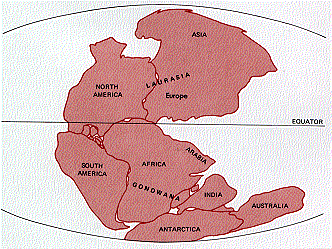18.12: Geologic Eras
- Page ID
- 5936
\( \newcommand{\vecs}[1]{\overset { \scriptstyle \rightharpoonup} {\mathbf{#1}} } \)
\( \newcommand{\vecd}[1]{\overset{-\!-\!\rightharpoonup}{\vphantom{a}\smash {#1}}} \)
\( \newcommand{\dsum}{\displaystyle\sum\limits} \)
\( \newcommand{\dint}{\displaystyle\int\limits} \)
\( \newcommand{\dlim}{\displaystyle\lim\limits} \)
\( \newcommand{\id}{\mathrm{id}}\) \( \newcommand{\Span}{\mathrm{span}}\)
( \newcommand{\kernel}{\mathrm{null}\,}\) \( \newcommand{\range}{\mathrm{range}\,}\)
\( \newcommand{\RealPart}{\mathrm{Re}}\) \( \newcommand{\ImaginaryPart}{\mathrm{Im}}\)
\( \newcommand{\Argument}{\mathrm{Arg}}\) \( \newcommand{\norm}[1]{\| #1 \|}\)
\( \newcommand{\inner}[2]{\langle #1, #2 \rangle}\)
\( \newcommand{\Span}{\mathrm{span}}\)
\( \newcommand{\id}{\mathrm{id}}\)
\( \newcommand{\Span}{\mathrm{span}}\)
\( \newcommand{\kernel}{\mathrm{null}\,}\)
\( \newcommand{\range}{\mathrm{range}\,}\)
\( \newcommand{\RealPart}{\mathrm{Re}}\)
\( \newcommand{\ImaginaryPart}{\mathrm{Im}}\)
\( \newcommand{\Argument}{\mathrm{Arg}}\)
\( \newcommand{\norm}[1]{\| #1 \|}\)
\( \newcommand{\inner}[2]{\langle #1, #2 \rangle}\)
\( \newcommand{\Span}{\mathrm{span}}\) \( \newcommand{\AA}{\unicode[.8,0]{x212B}}\)
\( \newcommand{\vectorA}[1]{\vec{#1}} % arrow\)
\( \newcommand{\vectorAt}[1]{\vec{\text{#1}}} % arrow\)
\( \newcommand{\vectorB}[1]{\overset { \scriptstyle \rightharpoonup} {\mathbf{#1}} } \)
\( \newcommand{\vectorC}[1]{\textbf{#1}} \)
\( \newcommand{\vectorD}[1]{\overrightarrow{#1}} \)
\( \newcommand{\vectorDt}[1]{\overrightarrow{\text{#1}}} \)
\( \newcommand{\vectE}[1]{\overset{-\!-\!\rightharpoonup}{\vphantom{a}\smash{\mathbf {#1}}}} \)
\( \newcommand{\vecs}[1]{\overset { \scriptstyle \rightharpoonup} {\mathbf{#1}} } \)
\( \newcommand{\vecd}[1]{\overset{-\!-\!\rightharpoonup}{\vphantom{a}\smash {#1}}} \)
\(\newcommand{\avec}{\mathbf a}\) \(\newcommand{\bvec}{\mathbf b}\) \(\newcommand{\cvec}{\mathbf c}\) \(\newcommand{\dvec}{\mathbf d}\) \(\newcommand{\dtil}{\widetilde{\mathbf d}}\) \(\newcommand{\evec}{\mathbf e}\) \(\newcommand{\fvec}{\mathbf f}\) \(\newcommand{\nvec}{\mathbf n}\) \(\newcommand{\pvec}{\mathbf p}\) \(\newcommand{\qvec}{\mathbf q}\) \(\newcommand{\svec}{\mathbf s}\) \(\newcommand{\tvec}{\mathbf t}\) \(\newcommand{\uvec}{\mathbf u}\) \(\newcommand{\vvec}{\mathbf v}\) \(\newcommand{\wvec}{\mathbf w}\) \(\newcommand{\xvec}{\mathbf x}\) \(\newcommand{\yvec}{\mathbf y}\) \(\newcommand{\zvec}{\mathbf z}\) \(\newcommand{\rvec}{\mathbf r}\) \(\newcommand{\mvec}{\mathbf m}\) \(\newcommand{\zerovec}{\mathbf 0}\) \(\newcommand{\onevec}{\mathbf 1}\) \(\newcommand{\real}{\mathbb R}\) \(\newcommand{\twovec}[2]{\left[\begin{array}{r}#1 \\ #2 \end{array}\right]}\) \(\newcommand{\ctwovec}[2]{\left[\begin{array}{c}#1 \\ #2 \end{array}\right]}\) \(\newcommand{\threevec}[3]{\left[\begin{array}{r}#1 \\ #2 \\ #3 \end{array}\right]}\) \(\newcommand{\cthreevec}[3]{\left[\begin{array}{c}#1 \\ #2 \\ #3 \end{array}\right]}\) \(\newcommand{\fourvec}[4]{\left[\begin{array}{r}#1 \\ #2 \\ #3 \\ #4 \end{array}\right]}\) \(\newcommand{\cfourvec}[4]{\left[\begin{array}{c}#1 \\ #2 \\ #3 \\ #4 \end{array}\right]}\) \(\newcommand{\fivevec}[5]{\left[\begin{array}{r}#1 \\ #2 \\ #3 \\ #4 \\ #5 \\ \end{array}\right]}\) \(\newcommand{\cfivevec}[5]{\left[\begin{array}{c}#1 \\ #2 \\ #3 \\ #4 \\ #5 \\ \end{array}\right]}\) \(\newcommand{\mattwo}[4]{\left[\begin{array}{rr}#1 \amp #2 \\ #3 \amp #4 \\ \end{array}\right]}\) \(\newcommand{\laspan}[1]{\text{Span}\{#1\}}\) \(\newcommand{\bcal}{\cal B}\) \(\newcommand{\ccal}{\cal C}\) \(\newcommand{\scal}{\cal S}\) \(\newcommand{\wcal}{\cal W}\) \(\newcommand{\ecal}{\cal E}\) \(\newcommand{\coords}[2]{\left\{#1\right\}_{#2}}\) \(\newcommand{\gray}[1]{\color{gray}{#1}}\) \(\newcommand{\lgray}[1]{\color{lightgray}{#1}}\) \(\newcommand{\rank}{\operatorname{rank}}\) \(\newcommand{\row}{\text{Row}}\) \(\newcommand{\col}{\text{Col}}\) \(\renewcommand{\row}{\text{Row}}\) \(\newcommand{\nul}{\text{Nul}}\) \(\newcommand{\var}{\text{Var}}\) \(\newcommand{\corr}{\text{corr}}\) \(\newcommand{\len}[1]{\left|#1\right|}\) \(\newcommand{\bbar}{\overline{\bvec}}\) \(\newcommand{\bhat}{\widehat{\bvec}}\) \(\newcommand{\bperp}{\bvec^\perp}\) \(\newcommand{\xhat}{\widehat{\xvec}}\) \(\newcommand{\vhat}{\widehat{\vvec}}\) \(\newcommand{\uhat}{\widehat{\uvec}}\) \(\newcommand{\what}{\widehat{\wvec}}\) \(\newcommand{\Sighat}{\widehat{\Sigma}}\) \(\newcommand{\lt}{<}\) \(\newcommand{\gt}{>}\) \(\newcommand{\amp}{&}\) \(\definecolor{fillinmathshade}{gray}{0.9}\)History of life as revealed by the fossil record
With help from molecular phylogenies:
| Eras | Periods | Epochs | Aquatic Life | Terrestrial Life |
|---|---|---|---|---|
| With approximate starting dates in millions of years ago in parentheses. Geologic features in green | ||||
| Cenozoic (66) The "Age of Mammals" |
||||
| Quaternary (2.6) | Holocene | Humans in the new world | ||
| Pleistocene | Periodic glaciation | First humans | ||
| Continental drift continues | ||||
| Neogene (23) | Pliocene | Atmospheric oxygen reaches today's level (21%) | Hominids | |
| Miocene | Adaptive radiation of birds, continued radiation of mammals | |||
| Paleogene (66) | Oligocene | All modern groups present | ||
| Eocene | ||||
| Paleocene | ||||
| Mesozoic (251) The "Age of Reptiles" |
Cretaceous (146) | Still attached: N. America & N. Europe; Australia & Antarctica; Mass extinction of both aquatic and terrestrial life at the end | ||
| Modern bony fishes | Extinction of dinosaurs and pterosaurs; first snakes | |||
| Extinction of ammonites, plesiosaurs, ichthyosaurs | Rise of angiosperms | |||
| Africa & S. America begin to drift apart | ||||
| Jurassic (200) | Plesiosaurs, ichthyosaurs abundant; first diatoms | Archaeopteryx; dinosaurs dominant but mammals (Eutheria) begin to diversify | ||
| Ammonites again abundant | First lizards | |||
| Skates, rays, and bony fishes abundant | Adaptive radiation of dinosaurs | |||
| Pangaea splits into Laurasia and Gondwana; atmospheric oxygen drops to ~13% | ||||
| Triassic (251) | Mass extinctions at the end. | Mass extinctions at the end. First mammals Adaptive radiation of reptiles: thecodonts, therapsids, turtles, crocodiles, first dinosaurs |
||
| Ammonites abundant at first | ||||
| Rise of bony fishes | ||||
| Paleozoic (542) | Permian (299) | Periodic glaciation and arid climate; atmospheric oxygen reaches ~30%. Volcanic eruptions killed off 90% of marine species at end. | ||
| Extinction of trilobites | Reptiles abundant. Cycads, conifers, ginkgos | |||
| Pennsylvanian (320) | Warm, humid climate Together the Pennsylvanian and Mississippian make up the "Carboniferous"; also called the "Age of Amphibians" |
|||
| Ammonites, bony fishes | First reptiles Coal swamps |
|||
| Mississippian (359) | Adaptive radiation of sharks | Forests of lycopsids, sphenopsids, and seed ferns Amphibians abundant Adaptive radiation of the insects (Hexapoda) |
||
| Atmospheric oxygen begins to rise as organic matter is buried, not respired | ||||
| Devonian (416) The "Age of Fishes" |
Extensive inland seas | Cartilaginous and bony fishes abundant. Ammonites, nautiloids, ostracoderms, eurypterids | Ferns, lycopsids, and sphenopsids First gymnosperms First amphibians |
|
| Silurian (443) | Mild climate; inland seas | First bony fishes | First myriapods and chelicerates | |
| Ordovician (485) | Mild climate, inland seas | Trilobites abundant | Fungi present First plants (liverworts?) First insects |
|
| Cambrian (541) | First vertebrates (jawless fishes). Eurypterids, crustaceans mollusks, echinoderms, sponges, cnidarians, annelids, and tunicates present. Trilobites dominant. |
No fossils of terrestrial eukaryotes, but phylogenetic trees suggest that lichens, mosses, perhaps even vascular plants were present. | ||
| Periodic glaciation | ||||
| Proterozoic (2500) | Ediacaran (635) |
Fossil evidence of multicellular algae, fungi, and bilaterian invertebrates | ||
| Evidence of eukaryotes ~1.8 x109 years ago |
||||
| Archaean (3600) | Evidence of archaea and bacteria ~3.5 x109 years ago |
|||
The Geologic and Evolutionary Record
A remarkable feature of the table above is how often evolutionary changes coincided with geologic changes on the earth. But consider that changes in geology (e.g., mountain formation or lowering of the sea level) cause changes in climate, and together these alter the habitats available for life. Two types of geologic change seem to have had especially dramatic effects on life: continental drift and the impact of asteroids
Continental Drift

A body of evidence, both geological and biological, supports the conclusion that 200 million years ago, at the start of the Mesozoic era, all the continents were attached to one another in a single land mass, which has been named Pangaea. This drawing of Pangaea (adapted from data of R. S. Dietz and J. C. Holden) is based on a computer-generated fit of the continents as they would look if the sea level were lowered by 6000 feet (~1800 meters). During the Triassic, Pangaea began to break up, first into two major land masses:
- Laurasia in the Northern Hemisphere
- Gondwana in the Southern Hemisphere.
The present continents separated at intervals throughout the remainder of the Mesozoic and through the Cenozoic, eventually reaching the positions they have today. Let us examine some of the evidence.
Shape of the Continents
The east coast of South America and the west coast of Africa and are strikingly complementary. This is even more dramatic when one tries to fit the continents together using the boundaries of the continental slopes, e.g., 6000 feet (~1800 meters) down, rather than the shorelines.
Geology
- In both mineral content and age, the rocks in a region on the east coast of Brazil match precisely those found in Ghana on the west coast of Africa.
- The low mountain ranges and rock types in New England and eastern Canada appear to be continued in parts of Great Britain, France, and Scandinavia.
- India and the southern part of Africa both show evidence of periodic glaciation during Paleozoic times (even though both are now close to the equator). The pattern of glacial deposits in the two regions not only match each other but also glacial deposits found in South America, Australia, and Antarctica.
Fossils
- Fossil reptiles found in South Africa are also found in Brazil and Argentina.
- Fossil amphibians and reptiles found in Antarctica are also found in South Africa, India, and China.
- Most of the marsupials alive today are confined to South America and Australia. But if these two continents were connected by Antarctica in the Mesozoic, one might expect to find fossil marsupials there. In March 1982, this prediction was fulfilled with the discovery in Antarctica of the remains of Polydolops, a 9-ft (2.7 m) marsupial.
The Impact Hypothesis
The Cretaceous period, the last period of the Mesozoic, marked the end of the Age of Reptiles. It was followed by the Cenozoic era, the Age of Mammals. Although extinctions have occurred throughout the history of life, an extraordinary number of them occurred in a relatively brief period at the end of the Cretaceous. Why?
The Alvarez Theory
Louis Alvarez, his son Walter, and their colleagues proposed that a giant asteroid or comet striking the earth some 66 million years ago caused the massive die-off at the end of the Cretaceous. Presumably, the impact generated so much dust and gases that skies were darkened all over the earth, photosynthesis declined, and worldwide temperatures dropped. The outcome was that as many as 75% of all species — including all dinosaurs — became extinct.
The key piece of evidence for the Alvarez hypothesis was the finding of thin deposits of clay containing the element iridium at the interface between the rocks of the Cretaceous and those of the Paleogene period (called the K-Pg boundary after the German word for Cretaceous). Iridium is a rare element on earth (although often discharged from volcanoes), but occurs in certain meteorites at concentrations thousands of times greater than in the earth's crust.
After languishing for many years, the Alvarez theory gained strong support from the discovery in the 1990s of the remains of a huge (180 km in diameter) crater in the Yucatan Peninsula that dated to 65 million years ago.
The abundance of sulfate-containing rock in the region suggests that the impact generated enormous amounts of sulfur dioxide (SO2), which later returned to earth as a bath of acid rain. A smaller crater in Iowa, formed at the same time, many have contributed to the devastation. Perhaps during this period the earth passed through a swarm of asteroids or a comet and the repeated impacts made the earth uninhabitable for so many creatures of the Mesozoic.
Other Impacts
A mass extinction of non-dinosaur reptiles occurred earlier, at the end of the Triassic. It was followed by a great expansion in the diversity of dinosaurs. The recent discovery of a layer enriched in iridium in rocks formed at the boundary between the Triassic and Jurassic suggests that impact from an asteroid or comet may have been responsible then just as it was at the K-Pg boundary.
The largest extinction of all time occurred still earlier at the end of the Permian period. There is evidence off the coast of Australia that a huge impact there may have contributed to the extinctions at the Permian-Triassic (P-T) boundary.


